How Much Light Does Your Home Provide?
...and when to call in an assist from a grow light or two!
 Not enough light in your home? Bamboo LED Grow Light Gardens allow you to grow light-loving plants in any room.
Not enough light in your home? Bamboo LED Grow Light Gardens allow you to grow light-loving plants in any room.Understanding a plant's native habitat gives clues to its care, and houseplants are no exception. Many common houseplants are native to the tropics, where the climate most closely approximates our homes' interiors — relatively stable temperatures, never freezing, with a range of light levels. In particular, many favorite houseplant species are adapted to the jungle understory beneath tall trees, where they bask in warmth, high humidity, and whatever sunlight filters through the tall trees' foliage. Other plants hail from sunnier, less humid climates. The closer you can come to replicating a houseplant's native habitat, the better your chance for success.
How much light does your plant need? The tag (or some quick research) should tell you if it requires direct sun; indirect light; medium light, or low light. View plant lists.
How to Tell How Much Sunlight a Room Has: The Shadow Test
I held this monstera leaf about 8" from a sheet of paper at various window locations on a sunny day.
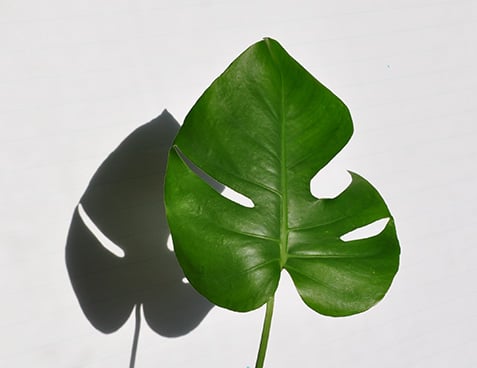 The strong outlines of this shadow indicate a bright light/direct sun location.
The strong outlines of this shadow indicate a bright light/direct sun location.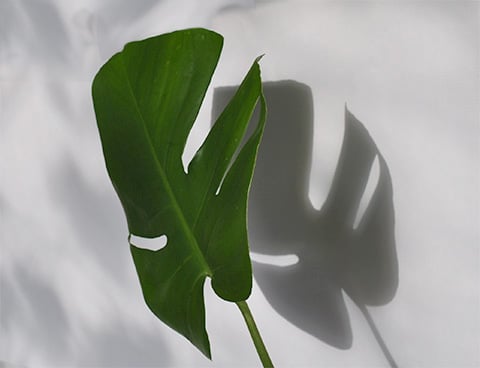 The strong outlines of the shadow are visible, but in the dappled light provided by trees just outside the window — a location with bright, indirect light.
The strong outlines of the shadow are visible, but in the dappled light provided by trees just outside the window — a location with bright, indirect light.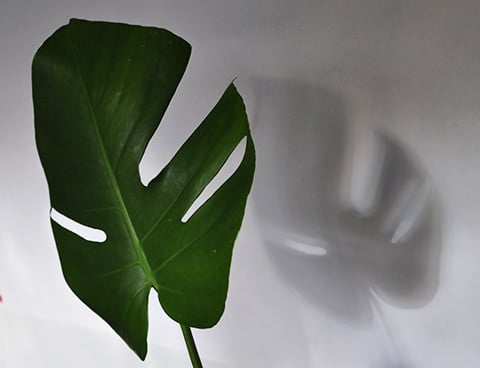 The leaf outlines are visible but weaker in this shadow, indicating a spot with medium light.
The leaf outlines are visible but weaker in this shadow, indicating a spot with medium light.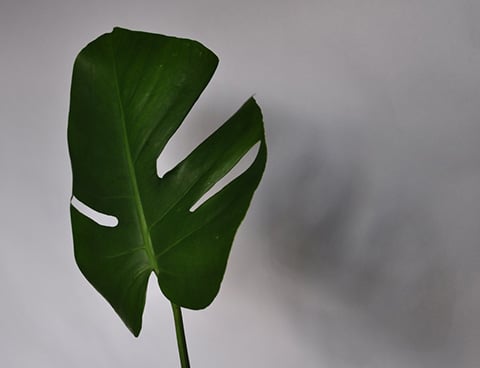 The diffuse shadow with no discernable outlines indicates a low-light area.
The diffuse shadow with no discernable outlines indicates a low-light area.
Relying on Window Light
Many of us assume that the sunlight coming through our windows will be adequate for our houseplant, and in some cases it is. However, light that passes through glass isn't as strong as direct, outdoor sunlight. Also, unless you're growing in a greenhouse, its brightness will change throughout the day depending on the dirction the window faces.
Other factors affecting the amount of sunlight coming through a window include the size of the window, eaves and overhangs, and shading by trees and buildings. In winter, the sun is lower in the sky so there may be more direct sun; however, the intensity is weaker than in summer, and there are fewer hours of daylight.
Here are some terms used to describe a houseplant's light preferences and the window location that might best suit it:
Bright light with some direct sun
In the northern hemisphere, the most sunlight will come into a south-facing window. However, the brightness and duration will depend on the factors above. West-facing windows offer shade in the morning, but direct sun in the afternoon. In summer, this is usually the hottest part of the day, so plants will receive some extra heat, too.
Bright, indirect light
Sheer curtains will transform the intense sunlight of a south-facing or west-facing window into the bright, indirect light favored by many houseplants. Another good location is an east-facing window, which provides a few hours of morning sun, which tends to be less intense and produce less heat than afternoon sun.
Medium light
As you move plants away from windows, the light intensity is lessened. Placing a medium-light plant about five feet in from a south- or west-facing window should provide adequate light.
Low light
Interior walls and north windows are often low-light areas. The more windows you have, the brighter your interior space will be. Note that plants described as "low light" generally tolerate low light, but would grow more vigorously with medium light. And no living plant will thrive in a very dark corner.
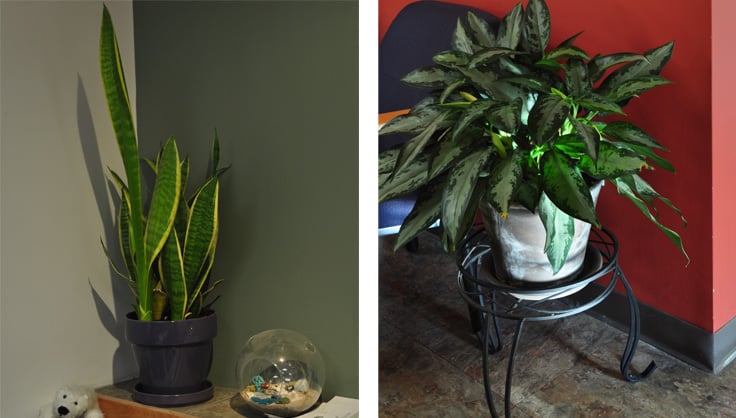 Left: Sansevieria (snake plant) and Aglaonema (Chinese evergreen) tolerate low-light conditions.
Left: Sansevieria (snake plant) and Aglaonema (Chinese evergreen) tolerate low-light conditions.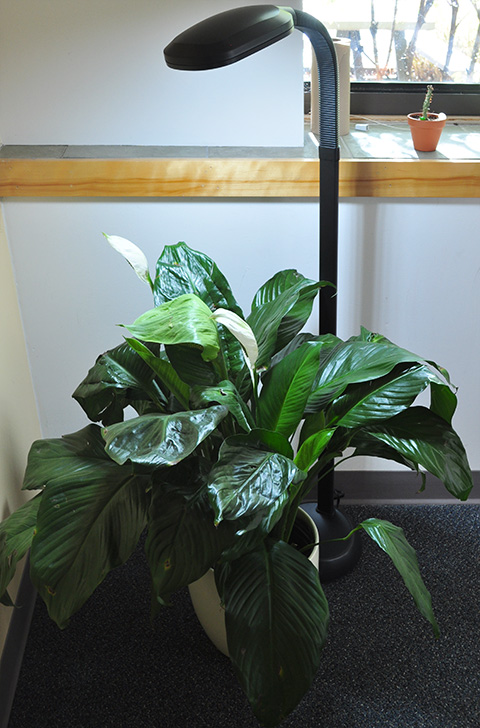
Too Dark: How to Add More Light
Although this peace lily (spathiphyllum) will tolerate low-light conditions, it is healthier, more vigorous, and produces more flowers if given more light. Here, it gets supplemental light from a full-spectrum grow light. What is "full spectrum"? Full spectrum bulbs will generally be between 5000 and 6500 K, and will mimic bright, natural sunlight in appearance. Like plants growing outdoors in the sunlight, indoor plants generally grow best under full-spectrum bulbs, which produce a balance of cool and warm light that replicates the natural solar spectrum. Read on and learn more about lighting terminology here!
Too Bright: How to Reduce Bright Light and Glare
If the sunlight coming in your window is just too much for your plants, you may notice symptoms such as scorched foliage and bleached flower colors, as well as increased pest problems, such as spider mites. There are many solutions to toning down the sunlight intensity. Sheer curtains will protect plants and create a more pleasing light environment for you. There are a range of light-filtering shades, fabrics, and films for windows. Or you can get creative with natural materials, like the woven fencing below.
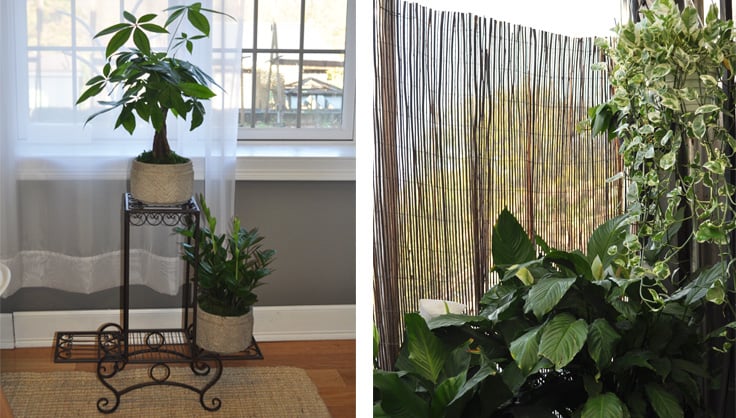 Left: Sheer curtains filter direct sunlight, so medium-light plants can thrive. A plant stand allows optimal placement. Right: Twig fencing creates an unusual and effective screen against bright sun and glare.
Left: Sheer curtains filter direct sunlight, so medium-light plants can thrive. A plant stand allows optimal placement. Right: Twig fencing creates an unusual and effective screen against bright sun and glare.
List of Common Houseplants by Their Lighting Needs
| Bright, Direct Light | Bright, Indirect Light | Medium Light | Low Light |
|
|
|
|
Print this Article:
Get the Dirt
Stay up to date on new articles and advice. Please fill out the information below.

